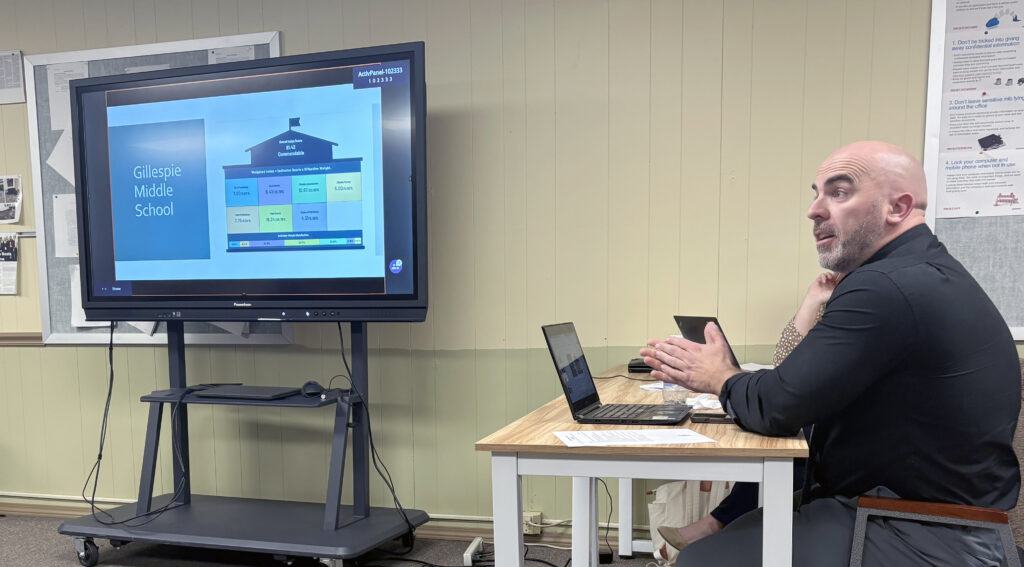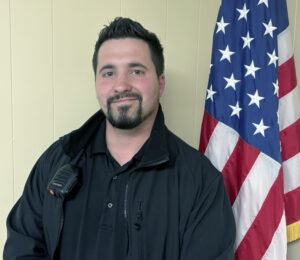CUSD 7 News
School Board authorizes vocational building project, hears plans for school opening during pandemic
Published
5 years agoon
By
Dave A

Members of the Community Unit School District 7 Board of Education selected a contractor Monday night to replace the roof and build an addition for the high school vocational education building but delayed a decision on the size of the addition. The board also heard extensive reports about how the district will open the school year with remote learning protocols in less than a month.
Continuing to observe COVID-19 protocols, the board met in the Gillespie Middle and High School cafeteria where board members sit six feet apart and wear face coverings.
David Leggans of Graham-Hyde Architects, Springfield, told the board that bids for the vocational building project came in over budget and that his firm recommended accepting a low bid from R.W. Boeker Construction, Hamel, to replace the roof and build an addition. Before stepping down as district superintendent, former Supt. Joe Tieman had told the board the vocational building improvements could be financed with $400,000 in vocational education grant funds, coupled with a $50,000 state matching grant—essentially allowing the district to underwrite a $50,000 project with only $50,000 in local funds.
Boeker Construction’s base bid for a new roof and a 30-foot addition, however, came in at $529,300—about $30,000 in excess of the architect’s estimate. Leggans told the board his firm was unsure of what to expect from bidders seeking contracts during the COVID-19 pandemic and was surprised to obtain bids fluctuating nearly $200,000 between the low and high bids.
Extending the building by 48 feet would require the removal and relocation of an existing greenhouse on the north side of the building. Boeker’s bid to remove and replace the greenhouse, Leggans said, was about $260,000. “That’s half of your budget,” he noted.
Board President Mark Hayes said the existing greenhouse was built by volunteers and questioned why the contractor’s bid exceeded $200,000. Leggans responded that volunteers would not be bound by the same state-mandated standards as the contractor. The new greenhouse, he said, would be a commercial grade greenhouse with a concrete floor, a sprinkler system for fire suppression and a glass outer shell. “What you have now is basically a framework with a plastic covering,” Leggans said. “As a school district, you can do that” but a contractor would have to build a facility meeting minimal standards.
Armed with that information, Hayes proposed accepting the higher bid to add 48 feet to the building and opting to use school personnel and volunteers to relocate the existing greenhouse. Supt. Shane Owsley calculated that the district’s “out of pocket” costs (excluding grant funds) for the 30-foot addition would amount to about $83,000. For the 48-foot addition, he said, the school’s out of pocket expenditures would nearly double—$146,000.
“My gut is that the larger addition is the better buy,” Hayes said, adding that the larger project would be consistent with the district’s goals of putting greater emphasis on vocational education.
Board member Jenni Alepra asked about the funds available to the district for capital improvements. Owsley said he did not have an exact number without researching the issue.
Hayes pointed out that the larger addition is consistent with plans the district has for vocational education “down the road.”
“We have a lot of things down the road,” Alepra said. “I don’t want to make another $146,000 decision in three or four seconds.”
Without having numbers available, Hayes asked if the decision could be delayed to a later meeting. Leggans responded that some decision would be needed in order the meet the timelines the contract specifies for the contractor. Under terms of the bidding specification, the contractor would be expected to begin site work prior to the start of the school year and completing the project by late November. Supt. Owsley suggested the possibility of accepting Boeker as the contractor and delaying a decision on the size of the addition.
“Let’s start the process,” Owsley said, while the board reaches a decision on the scope of the project.
Given the time frame, Hayes moved to accept Boeker’s low bid, but before a vote could be taken, Alepra sought clarification. Owsley and Hayes said the motion was to accept the bid for the smaller addition while reserving the option to authorize a larger addition later in the construction process.
“If we decide to change that, we can?” Alepra asked.
“Yes,” said Leggans, adding that such a change would require a change order to the contract.
Brought to a vote, the board unanimously agreed to accept Boeker’s base bid and authorized the project to proceed.
PLANS EVOLVE FOR STARTING SCHOOL YEAR
By a unanimous vote, the board approved a resolution authorizing the superintendent to plan and implement reopening plans for CUSD 7 schools. Among other considerations, the resolution requires the superintendent to take into consideration the health and safety of students, staff and the community; educational and social/emotional needs of students; transportation issues; technology needs; social distancing requirements; health screenings; sanitation and disinfecting protocols; and provisions for personal protective equipment. The resolution further authorizes the superintendent to solicit and rely upon information from the State Board of Education, Illinois High School Association, Illinois Elementary School Association, CDC and other resources. In addition to authorizing the superintendent to make decisions about the delivery of educational services, the resolution also authorizes the superintendent to make and implement decisions about extra-curricular and co-curricular activities.

The authorities granted by the resolution expire at the end of summer school offerings in 2021 unless the board takes action to revoke the resolution prior to that time.
Last week during a special meeting of the board, Supt. Owsley announced that the 2020-21 school year will start as last year ended with remote learning. Depending upon the evolving pandemic, the district may move to in-classroom learning later in the year with specific protocols in place. In that event, students would attend school four days a week with one day set aside for cleaning and sanitizing school facilities. All students, staff and visitors would have their temperatures taken before entering the school. All persons would be required to wear face coverings and practice social distancing. Students would be subject to an abbreviated schedule with older students attending during the morning and younger students attending in the afternoon.
Reporting to the board Monday night, High School Principal Jill Rosentreter said building principals had been working together to make plans for the new school year. She said the Remote Learning Plan and In-Person Plan both have been subject to changes as new guidance becomes available from the State Board of Education and other agencies. Additionally, she said updates were made in conjunction with input from the teachers union, teachers and non-certified staff. Among the issues under discussion are daily schedules, instructional expectations, family communication, safety protocols and staff responsibilities.
Rosentreter said teachers have been learning to use Microsoft Teams which will be the remote learning platform for grades 4-12, and well as working with the Skyward, a school management software.
The new school year will open with “distribution” days on Monday and Tuesday, Aug. 17 and 18, during which students are expected to go to their respective schools to pick up laptop computers, textbooks, assignments and other materials for the start of the school year.
At the BenGil Elementary School, teachers will schedule times for students/parents to enter the building so the number of persons in the building can be closely monitored. All persons entering the building must wear a face covering and all persons must have their temperature taken to enter. Fourth and fifth-grade students will receive a laptop computer for remote learning, along with other materials. Each computer will be accompanied by an operator’s manual and a copy of the district’s policy regarding the use of district computers. Only one student/parent at a time will be allowed in their teacher’s classroom and will spend no more than 15 minutes in the classroom. Students are encouraged to bring their book bags to carry materials. Teachers will be provided with rubber gloves and hand sanitizer will be available throughout the building.
Seventh and eighth-grade students are set to come to the Gillespie Middle School to pick up materials on Aug. 17. Recommended arrival times for seventh-grade students with last names beginning with the letters A-H from 8 a.m. to 9 a.m.; seventh-graders with names starting with the letters I-P will arrive between 9 a.m. and 10 a.m.; and those with last names starting with the letters Q-Z will arrive between 10 a.m. and 11 a.m. Eighth graders also will arrive on Aug. 17, with the following recommended arrival times: last names starting with A-H from noon to 1 p.m.; I-P from 1-2 p.m.; and Q-Z, 2-3 p.m.
Distribution day for sixth-grade students will be on Aug. 18 with the following recommended arrival times; students with last names starting with the letters A-E from 8 a.m. to 9 a.m.; F-J, 9-10 a.m.; K-O, 10-11 a.m.; P-T, noon to 1 p.m., and U-Z, 1-2 p.m.
The number of students in the Middle School building will be limited to about 25 at any one time. Symptom checks, including temperature, will be taken at the door. Students will be encouraged to bring their book bags to carry materials. Face coverings will be required for all persons in the building. After the first meeting with their homeroom teacher, each student will move from room to room to receive materials from their other teachers, spending about three minutes at each station. Middle school students also will receive a laptop computer, along with an operator’s manual and a copy of the school policy on computer use. Teachers will be provided with rubber gloves and hand sanitizer will be available throughout the building.
High school freshmen will receive materials on Monday, Aug. 17, with the following recommended schedule: students with last names starting with the letters A-G from 8 a.m. to 9 a.m.; H-O, 9-10 a.m.; and P-Z, 10-11 a.m. Sophomores also will arrive on Aug. 17 with the following recommended schedule: A-G, noon to 1 p.m.; H-O, 1-2 p.m.; and P-Z, 2-3 p.m. Juniors and seniors with pick up materials on Aug. 18 with juniors expected on the following recommended schedule: A-G, 8-9 a.m.; H-O, 9-10 a.m.; and P-Z, 10-11 a.m. Seniors are expected to arrive on the following recommended schedule: A-G, noon to 1 p.m.; H-O, 1-2 p.m.; and P-Z, 2-3 p.m.
As with the Middle School, the number of students in the building will be limited to about 25 at any one time. Each person entering the building will undergo a symptom check, including temperature. Students will enter through the south breezeway door and exit through the south English hallway door. All persons in the building will be required to wear a face covering. Students will be given their laptop computer and enough instructional materials to last through the midterm. Students will spend three to four minutes in the classroom for each of their classes in order to meet teachers and receive materials. Teachers will be provided with rubber gloves and hand sanitizer will be available throughout the building.
Administrators told the board that plans for distributing materials could be adjusted on the basis of new recommended protocols from the Macoupin County Public Health Department.
Owsley said the district is trying to provide the “safest environment possible” for students, staff, and the public. He said he is in contact with the County Health Department every week. The re-opening plan is necessarily fluid, he said, because of new information becoming available.
“For example, as of Friday, the state provided new rules,” he said. “About the time we think we have things figured out, we get new recommendations.”
In two matters related to the re-opening plan, the board voted unanimously to add a $50 technology fee to the schedule of student fees to defray the cost of providing computers to students, and unanimously approved on seconded reading a new policy requiring all students, staff and visitors to wear face masks within school facilities.
Board member Don Dobrino asked if the computers will be given to students when they complete their senior year. Owsley said that is the intention, but he has to check rules regarding the distribution of the equipment since the district is using grant funds to buy the devices.
The face mask policy includes penalties for students who refuse to comply. A student not wearing a face mask can be sent home for the day upon the first offense. Upon the second offense, the suspension is increased to one week and the suspension is increased to the remainder of the school year upon the third offense.
Owsley reported to the board that he recently learned that the district will receive about $86,850 from the state’s COVID-19 School Relief Fund, a portion of which can be used to acquire an additional 29 laptop computers for student use. He also reported that the community has responded to the pandemic by donating goods and services to the district. Among the donations received are free face masks provided by one of the sports boosters groups and sanitation wipes donated by a local insurance agent. Verticchio Law Office, one of the attorneys representing the district, has offered to write living wills and power-of-attorney documents for teachers returning to the classroom amid the pandemic. “We’ve got lots of support from the community,” Owsley said.
EAGLE SCOUT PROJECT
The board took under advisement a request from Troy Boy Scout member Justin Spencer to have access to a parcel of property next to the district’s storage shed on the north side of Illinois Route 16 for an Eagle Scout Project. Spencer said he needs a small area to erect a 12-by-seven-foot welcome sign reading “Welcome to Gillespie-Home of the Miners.” Owsley said he would consult with Building Manager Rob Graham and get back to Spencer with a decision.
PERSONNEL
In other action, the board voted to hire Michael Smith as a full-time, full-route bus driver and to post a vacancy for a high school softball coaching position.
Comments
You may like
-
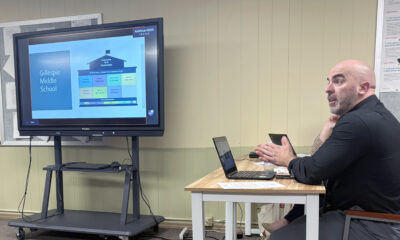

School board approves $3.9 million tax levy request; Eyes annual ISBE report cards
-


Gillespie gears up for 4th Annual Lighted Parade and Community Tree Lighting
-
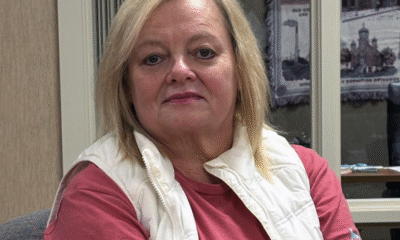

Long-serving Benld City Treasurer resigns
-


County board approves long-awaited AFSCME contract
-


Gillespie Council honors retiring police officer
-


Oberkfell repeats as state cross country champion
Community News
School board approves $3.9 million tax levy request; Eyes annual ISBE report cards
Published
1 week agoon
November 26, 2025By
Dave A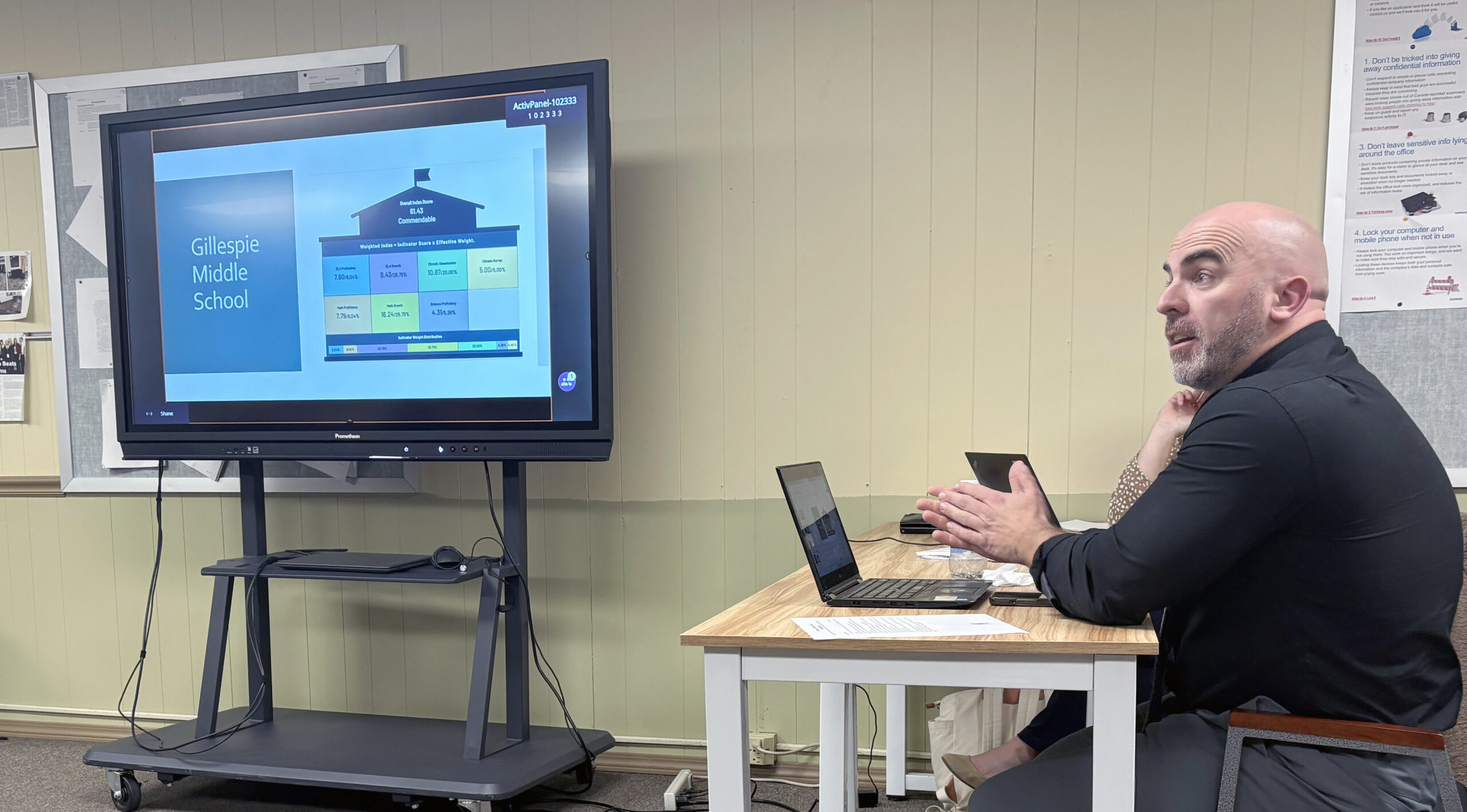
Members of the Community Unit School District 7 Board of Education on Monday night voted to approve a property tax levy request totaling $3,920,295 for 2025 property taxes payable in 2026. Because of tax caps and other factors, however, the district expects to collect only an estimated $3,786,607 of the requested amount.
In addition to acting on the tax levy, the board also held a lengthy discussion regarding annual district “report cards” issued by the Illinois State Board of Education to assess school performance from last year, approved a high school band/choir performance trip to Chicago in March, and agreed to apply for a school maintenance grant of up to $50,000 in matching funds.
The new proposed levy exceeds last year’s tax extension of $3,599,569 by more than $320,726—an increase of about nine percent if the levy were to be approved at the county level. The more realistic anticipation of $3,786,607 exceeds last year’s extension by $187,038, or an increase of about three percent. A Property Tax Extension Limitation Law (PTELL), approved by Macoupin County voters in 1995, restricts increases in the levy to five percent or the federal Consumer Price Index (CPI), whichever is less. This year’s CPI is estimated at 2.9 percent.
The approved levy seeks $1,650,000 for the Education Fund while expecting to realize $1,653,831; $450,229 for Operations & Maintenance, while anticipating $438,041; $200,000 for Transportation while expecting $180,434; $35,000 for Working Cash while expecting $42,602; $174,700 for the Illinois Municipal Retirement Fund while anticipating $117,788; $154,101 for Social Security while expecting $105, 248; $247,264 for Tort while anticipating $240,570; and $33,501 for Special Education while expecting $32,593. For Bond and Interest, which is not subject to PTELL, the district is levying $975,500 while anticipating the same amount.
Local property tax revenue accounts for about 20 percent of the district’s overall annual budget.
Because the levy request exceeds 105 percent of the previous year’s extension, a public hearing is required. That hearing is scheduled at the start of the board’s regular December meeting at 6 p.m., Monday, Dec. 15. In the meantime, the proposed levy is available for public inspection on the district’s website and in the district office.
Using a PowerPoint presentation, Owsley emphasized the levy request is essentially a wish list for what the district would like to raise through property taxes.
“The levy is the ‘Christmas list’ I talk about every year,” Owsley said. “If you don’t put it on the list, you’re not going to get it.”
Projecting what the district can legally seek under tax caps can be challenging because the district’s total equalized assessed valuation will not be confirmed until after Jan. 1 while state law requires the district to file its levy request before the end of December. For that reason, local school districts routinely file requests that exceed what they actually expect to receive in property tax revenue, and rely on the County Clerk to adjust the request to the maximum amount the district can receive.
“Because of tax caps, we have one shot to capture increases in the EAV and new construction,” Owsley said. “If we don’t do that, we lose it in perpetuity.”
To calculate the new levy, Owsley projected a 15.12 percent increase in the EAV—nearly double the previous year’s rate of increase. By overestimating the EAV growth, the district expects to capture the entire increase in assessed valuation when that number is finally determined.
“Even though we know the EAV will likely be around the historical average, we base our levy on a much higher amount so as not to lose revenue from new growth,” Owsley told the board. “We can do this without running the risk of overtaxing taxpayers because the district will receive no more than what we are entitled to by law.”
Owsley said relatively stable increases in EAV have resulted in a steadily declining tax rate. Since 2014 when the rate was $4.24 per $100 in EAV, the rate has fallen to $3.20 for 2024. In other words, the county can use a lower rate to generate the extension to which the district is entitled because the value of taxable property has increased.
“As long as the EAV goes up by more than the Consumer Price Index, our tax rates are going to go down,” Owsley noted.
SCHOOL DISTRICT REPORT CARDS
The board spent several minutes discussing recently released school report cards issued by the Illinois State Board of Education. Interested persons can view local report cards by visiting https://www.illinoisreportcard.com/.
All three attendance centers received a “Commendable” designation, meaning there are no student groups that are underperforming academically, and the high school graduation rate exceeds 67 percent. Last year, BenGil Elementary School achieved an “Exemplary” designation—the top designation a school can achieve.
Elementary Principal Angela Sandretto said administrators knew the school would not earn an Exemplary rating, even though students are state average in English/language arts, math and science. The Report Card designations are based on growth rather than academic performance. With students already exceeding state standards last year, the opportunity for growth was limited.
Assistant Principal Tara Cooper agreed, noting BenGil Elementary’s student performance is in the upper half of schools statewide that are meeting academic standards. “So, while we are not ‘Exemplary,’ we’re very happy with where we are.”
Supt. Owsley told the board the State Board of Education is working on revamping the assessment system because of the growth vs. performance issue. “That’s why they’re redoing all of this because they are penalizing schools for meeting goals,” he said.
For Gillespie Middle School, the report card shows students meeting or exceeding state averages in math and science but significantly lagging in English/language arts.
“ELA is our most concerning area,” Principal Patrick McGinthy told the board, “along with absenteeism.” The report card shows a chronic absenteeism rate of 25 percent, but Owsley and other administrators said the rate is exacerbated by the State Board of Education including nearly all absences whether or not they are excused.
Rosentreter noted the State Board will allow a student to be absent five days for illness without a doctor’s excuse. On the sixth day, however, the absence is unexcused unless the parent or guardian provides a doctor’s slip. Many parents, however, are reluctant to pay for a doctor’s visit for a child that is suffering from a minor illness.
McGinthy said Middle School teachers are attempting to address the deficiency in English/language arts by increasing writing exercises and requiring students to write in conjunction with other curriculum areas.
Rosentreter noted that the assessment standards for high schools differ from the standards for elementary and middle schools in that the State Board emphasizes graduation rates. For Gillespie, the graduation rate is an impressive 86 percent, though chronic absenteeism checks in at 31 percent.
“Math is definitely our shining star,” Rosentreter said, noting the school scored 17.8 points compared with the state average of 18. The school performed less well in the areas of English/language arts and science, scoring 16 points on ELA compared with the state score of 18 and 17.2 points compared with the state average of 19.
The report cards are based on results for the Illinois Assessment of Readiness (IAR) test for elementary and middle school students, and ACT scores for high school students.
Administrators said it’s difficult to motivate students to do well on state-mandated tests since the tests do not affect the student’s grade point average. To incentivize testing, Rosentreter said the high school is offering to let students skip final exams if they hit state standards on the mandated tests.
Owsley noted that the district report card documents the continuing decline in school enrollment—dropping from 1,325 seven years ago to 1,082 for the 2024-25 academic year.
“We don’t see that turning around anytime soon,” Owsley said. “It’s not just a Gillespie thing; it’s a trend for schools throughout Macoupin County.
BAND/CHOIR TRIP TO CHICAGO
Following a presentation by band/choir instructor Brad Taulbee, the board approved a high school band and choir performance tour to Chicago set for March 19-21. Taulbee said the tour company retained for the trip places emphasis on security and safety for traveling students. The company supplements hotel security with its own security personnel to monitor student rooms during the trip.
The tour includes workshop sessions at Vandercook College in downtown Chicago, and performances by the choir at the John Hancock Center and by the band at one of the city’s museums.
Taulbee said he is attempting to keep the cost affordable for participating students. Depending upon the number of students who ultimately go on the trip, he said he expects the cost to be about $739 per person. Additionally, he is lining up sponsors who can help with expenses for students who could not otherwise afford to participate.
“Security is my main concern,” said Board President Mark Hayes. “We just came back from there and seven people were shot in the area we were in.”
Taulbee said he expects to recruit seven to 10 chaperones and will ensure that the ratio of students to chaperones does not exceed 1:10.
SCHOOL MAINTENANCE GRANT
The board concurred with Supt. Owsley’s recommendation to again apply for a state School Maintenance grant of up to $50,000. The grant is a “matching” grant requiring the district to match grant funds dollar for dollar. The district has successfully applied for the grant for the past several years.
If the application is successful, Owsley said the funds will likely be used to remove asbestos-containing floor tiles in the choir room and elsewhere in the Middle School.
PERSONNEL
Following an executive session of about 40 minutes to discuss personnel and other issues, the board voted unanimously to accept the resignation of Tim Wargo as an assistant high school baseball coach and post the position as vacant, and voted to appoint Wargo as the head high school baseball coach for the coming season.
In separate actions, the board approved maternity leaves for Alexis Lupkey, district paraprofessional, and Gear-Up Coordinator Jordan Bartok. Lupkey’s leave is tentatively scheduled from Dec. 8 through March 18. Bartok’s leave is expected from Dec. 12 through Jan.6.
Board members voted unanimously to hire Christopher Whaley as a substitute bus driver, pending a routine background check and documentation of certification.
The board also voted unanimously to terminate Makayla Huff as a three-hour cook and post the position as vacant.
On a motion by Bill Carter, seconded by Weye Schmidt, the board voted unanimously to rehire fall coaches as follows: Jordan Bartok as head high school girls volleyball coach with Shelsie Price, as an assistant coach; Cory Bonstead as head football coach with Nate Henrichs, Jarrod Herron, Korben Clark, Alex Jasper, J.O. Kelly, Billy Gill and Florian Seferi as assistant and volunteer assistant coaches; Jay Weber as head coach for the parent-funded high school cross-country program with Jack Burns as a volunteer assistant coach; Jake Kellebrew as head coach for the parent-funded high school golf program, with Michael Otten as a volunteer assistant coach; Tim Wargo as head middle school baseball coach with Trae Wargo as assistant coach; Michelle Smith as head middle school softball coach with Jim Matesa, Joe Kelly and Melissa Heigert as assistant coaches; and Liz Thackery as head coach for the parent-funded middle school cross-country program with Laura Peterson as a volunteer assistant coach.
DISTRICT FOCUS
During a District Focus segment, Supt. Owsley introduced newly hired School Resource Officer Jacob Linhart, and High School Principal provided a report with photos of a recent school-wide Veterans Day observance.
Linhart, who has served five years as a police officer on the Gillespie Police Department, replaces Wade Hendricks, who recently retired after serving three years as the CUSD 7 School Resource Officer.
Linhart said it is a “great privilege” to serve as a Resource Officer, protecting students and staff. “I’m honored that you guys are allowing me to do it,” he said.
High School Principal Rosentreter said the school served breakfast to about 200 veterans and their families Tuesday morning, Nov. 11. Later, the veterans were joined by nearly 700 high school and middle school students for a recognition ceremony in the high school gymnasium.
Since the event coincided with the 25th anniversary of CUSD 7’s Wall of Honor program, the annual event did double duty as an induction ceremony for five are individuals, all of whom happened to be U.S. Military veterans.
The inductees included the late Sergeant Major John Marion Malnar, Command Sergeant Major John “Jack” Burns, Colonel Mark Daley, Lieutenant Colonel William P. Falke and Captain Robert Leone. Rosentreter said Daley and Leone traveled with their families from Colorado and Texas, respectively, to attend the ceremonies.
Burns, a retired CUSD 7 teacher, later visited BenGil Elementary School to present a program and teach students how to properly fold an American flag.
Rosentreter recognized the City of Gillespie for a donation of $1,000 to help purchase food for the veterans.
Born in Benld and a resident of Sawyerville, “Big John” Malnar earned a Silver Star during the Korean Conflict and a Gold Star, awarded posthumously after he was killed in action in 1968 in Vietnam. A Marine training center at Camp Geiger in North Carolina is named in his honor.
Though not a Wall of Honor inductee, Jacob Miller, a 100-year-old World War II veteran and recipient of two Purple Hearts, was recognized with a standing ovation.
The annual Veterans Day breakfast and ceremony provides students with an opportunity to meet and recognize local veterans as potential role models for their own futures.
Owsley said the event is a major event on the district’s calendar which grew out of a simple flagpole ceremony initiated 25 years ago.
CEJA GRANT FUNDS
Board members briefly discussed plans for about $74,000 in anticipated Climate and Equitable Jobs Act (CEJA) grant funds. The federal program is intended to compensate communities that have experienced revenue loss as a result of coal mine closures.
Owsley said the district committed about $86,000 in last year’s CEJA grant funds to the City of Gillespie to help pay for improvements to Plum Street, which is heavily used by district school buses. He has not transferred those funds, however, pending the start of the project.
Owsley said he was seeking the board’s input on how the money should be used.
“We could continue to partner with the city on Plum Street,” he said. “But there are plenty of project areas within the school.” The money could be used, for example, for continuing asbestos abatement. He identified other upcoming needs, including a new roof for the high school/middle school and an HVAC project.
President Hayes pointed out the school district paid for improvements to Kelly Street when BenGil Elementary was built and subsidized a project to reconfigure drainage on Broadway Street, in addition to the dollars committed for Plum Street.
“The school district is not in the business of building roads,” he said. “I think we’ve been more than generous with the city.”
Board member Peyton Bernot agreed the money should be committed for use by the school district.
TRIPLE I CONFERENCE
Several board members who attended a conference for board members and administrators Friday-Saturday, Nov. 21-23, in Chicago, commented briefly about their take-aways from conference sessions. Popularly known as the Triple I Conference, the convention is sponsored by the Illinois Association of School Boards, Illinois Association of School Administrators and the Illinois Association of School Business Officials.
Owsley said more than 700 Illinois school districts were represented, making the Triple I the largest gathering of education professionals in North America.
Bernot briefly reported on a session he attended regarding upcoming legislation and financial outlooks for school districts. He described the session as “much less optimistic” than sessions he’s attended in the past.
Owsley was among the convention presenters, discussing social-emotional learning. He commented that several districts attending reported efforts to involve students in school administrators. Some districts, he said, appointed a non-voting student representative to the school board to take part in discussions directly affecting students.
“When you think about it, we hear from faculty members and we hear from parents,” Hayes commented. “The people we don’t hear from are the most important part of what we do.”
Comments
Community News
Gillespie High School releases first quarter honor roll
Published
1 month agoon
October 31, 2025By
BenGil Staff
Class of 2026 (Seniors)
High honor roll: Emily Bergen, Deshaunta Cooper Jackson, Marshall Garwood, Katherine Gerdes, Carson Hailstone, Jule Hansmann, Jersey Helvey, Lillianna Jones, Ava Parish, Kori Petersen, Ava Rakers, Sean Roach, Lucas Rosenthal, Luke Schuckenbrock, Brody Shaw, Carter Sies, Nevaeh Thomas, Hailey Young
Honor roll: Anthony Amoroso, Jacob Baglin, Ceanna Bearden, Mark Caselton, Edin Compton, Carson Cooper, Addison Cox, Jackson Crook, Brookelyn Crotchett, Brayden Enslow, Hank Fletcher, Collin Griffith, Madyson Grogg, Luna Gross, Hunter Hegel, Elin Herold, Roadie Jackson, Kayden Koelker, Kyle Kottman, Cedrick Krieder, Dawson Lancaster, Sophia Lewis, Aiden Manley, Jessalyn McElyea, Mylee Mckee, Dawson Morgan, Douglas Neverdowski, David Norville, Chaz Oberkfell, Tyler Palmer, Lukas Parish, Zachary Phillips, Makayla Price, Joseph Reid, Paxton Reid, Desiree Rife, Ava Segarra, Brock Sherman, Sadie Sholtis, Nathan Spencer, Carman Toprani, Brooklyn VanHuss, Kaia Vickery, Whelen Walker, Claire Wallace
Class of 2027 (Juniors)
High honor roll: Jack Bulla, Olivia Crumley, Emily Helvey, Cole Katich, Olivia Kelly, Tember Miller, Cheyenne Sarti
Honor roll: Zowe Badolato, Jaxon Ballinger, Logan Belcher, Clayton Bethard, Sloane Brawner, Wrigley Bruhn, Mitchell Clark, Keenin Compton, Lillian Conner, Riley Cox, Briley Flournoy, Margaret Heyen, Marli Johnson, Lucca Kapp, Zaden King, Isaac Kravanya, Michael Marcacci, Braxten Noll, Adam Peterson, Matthew Plovich, William Ranger Fleshman, Wesley Reiman, Cash Reynolds, Karlee Rhodes, Landon Ridenhour, Kolten Robbins Lasica, Alex Schoen, Laci Schuckenbrock, Emilia Segarra, Carter Segrest, Jasmine Smith, Cali Stagner, Emerson Striegel, Payten Taylor, Caleb Thompson, Amari Vickery, Aedan Watson, Macie Williams, Maxwell Young
Class of 2028 (Sophomores)
High honor roll: Cali Barkley, Scarlet Bruhn
Honor roll: Bryce Alpi, Gracelynn Balestri, Dallas Barker, Alexis Brown, Logan Buhs, Aleeyah Busch, Jasper Calcari, Ava Carr, Annabelle Daniels, Tegan Davis, Tess Dixon, Lyla Drewel, Madison Durston, Kylie Edge, Lainey Edwards, Floritza Garcia Santiago, Katie Hamann, Keegan Hartpence, Kullen Hartpence, Hadyn Hegel, Olivia Hitos Colino, Nolan Hostettler, Levi Hughes, Henry Knetzer, Sophie Knetzer, Cory Knotts, Paige Marcum, Noah Marks, Kyndall McElyea, Weston Melchert, Alexis Nalley, Preston Noe, Stephen Otten, Elijah Pabon, Urijah Pabon, Brianna Phillips, Benjamin Pruitt, Braden Reich, Caitlynn Rhodes, Nolan Ruyle, Alyssa Saathoff, Kendall Schweppe, Helaina Scott, Destini Smith, Gillian Smith, Aliana Snow, Xzavier Spencer, Rafe Stangle, Richetti Stewart, Bryce Stoecker, Addisyn Tallman, Madisyn Thomas, Ayden Vernish, Luke Walker, Matrix Wright, Carter Young
Class of 2029 (Freshmen)
High honor roll: Collins Hagan, Marlee Hebenstreit, Paige Swank
Honor roll: Alesana Adams, Ella Brawner, Audrina Burkel, Bryson Cox, Chyla Crainick, Rayne Crites, Joshua Crumley, Thodrick Dirks, Mariella Garrison, Rylee Geisler, Landyn Hagler, Owen Hammann, Kai Hampson, Regan Harbaugh, Isabella Harbour, Gavin Horner, Alexander Jacobs, Alex Johnson, Giana Kapp, Addeline Laflin, Izzabella Manus, Frank Montoro, Storm Moreland, Amaelie Patterson, Dominique Payne Jr., Benjamin Peterson, Lila Polach, Avianna Ranger Fleshman, Marxon Rolando, Dominic Savant, Jackson Schardan, Jacob Schuette, Kristina Schuette, Lyla Shaw, Holden Sies, Kelleigh Simmons, Hanley Stoecker, Addyson Strang, Graham Striegel, Jacob Walker, Payton Welch, Bryleigh Whaley, Cole Williamson, Sydney Wilson, Michael Yeager
Comments
Community News
School board accepts annual financial report, chooses property/liability insurance policy
Published
1 month agoon
October 29, 2025By
Dave A

Members of the Community Unit School District 7 Board of Education on Monday night voted unanimously to accept the district’s annual financial report, chose an insurance carrier for property and liability, and authorized the Superintendent to apply for an administrative expenditures waiver.
Following a lengthy executive session, the board also voted 4-1 to expel an elementary student for the remainder of the school year, one of the youngest students the board has ever cited for expulsion. Board member Peyton Bernot cast the sole negative vote. Board members Amanda Ross, Dennis Tiburzi, Kelli Vesper and Weye Schmidt all voted to approve the disciplinary action. Board member Bill Carter was absent. There are no alternative school programs for students below the sixth grade. The expelled student reportedly will have an opportunity to continue classwork via an online program and will be provided with access to school counseling services.
Ken Loy, an accountant with Loy-Miller-Talley Public Accountants, Alton, told board members that the annual audit resulted in a “clean, unmodified” opinion from the auditors, meaning there were no descrepancies in the district’s accounting procedures for the fiscal year that ended June 30. The audit, which is required by state law, contains three opinion letters, all of which were positive in regard to the district’s accounting and fiscal management.
One letter is a general report of the auditors’ findings, indicating the district’s financial records “present fairly, in all material aspects, the assets and liabilities arising from cash transactions of balances of each fund.” Further, the report affirms, “the revenues (the district) received and expenditures it paid for the year . . . (are) in accordance with provisions of the State Board of Education.”
A second letter describes the scope of the auditing process, while a third letter addresses the district’s handling of federal funds. Loy said the federal letter is required when a district receives more than $750,000 in federal funds. For the most recent fiscal year, the district received about $2.5 million from federal sources. While that revenue triggered the need for a separate opinion letter, Loy said the amount was down somewhat from the past few years when the district was receiving COVID recovery funds. As with the general letter, the federal report reflects “a good, clean audit report,” according to Loy.
“All of these opinion letters are good as they have been in the past,” Loy said.
Zeroing in on some details of the 75-page audit, Loy noted that all funds ended the fiscal year in the black, except for the Illinois Municipal Retirement Fund which spent about $33,000 more than it received in revenue. However, Loy said, that deficit was a planned deficit that drew down on surplus balances.
“All of your other funds were positive,” he noted.
The district’s total equalized assessment value, the basis for property tax extensions, increased to $112,324,042 from $103,564,334 a year earlier, which was up from $95,324,343. The property tax extension for 2024, payable in 2025, was $3,599,569. The board typically sets the levy for the upcoming tax year in December.
The per capita tuition charge, determined by dividing enrollment into the total cost of education, increased from $8,892 for fiscal 2024 to $13,248 for fiscal 2025—due, in part, to a dramatic decrease in enrollment. The report notes that enrollment dropped from 1,005 in 2024 to 871 in 2025. That decline in enrollment, according to Loy, resulted in about $2,000 of the increased tuition charge.
Loy said the enrollment erosion is not unusual in downstate school districts.
“Our rural communities are aging,” he said. “We don’t have the size of families we used to have.”
Loy noted that the district’s state financial profile score increased from 3.7 out of 4.0 for fiscal 2024 to 3.8 for the most recently concluded fiscal year. The score identifies the district as a “Recognition Status” district, the highest ranking for financial health and stability.
“Your score went up a little bit because your debt went down,” Loy said. “At the same time, your capacity to borrow went up.”
Of the four criteria the State Board of Education uses to determine the score, CUSD 7 fell short of a 4.0 score in only the area of debt to income ratio.
“If not for the substantial debt, you would have had a perfect score,” Loy noted.
Supt. Shane Owsley told the board that some of the debt that’s bringing down the district’s financial score is lingering debt associated with the loss of Benld Elementary School and the construction of the BenGil Elementary School. The district secured special state legislation allowing it to exceed its normal debt ceiling to deal with the mine subsidence crisis. While that debt does not count toward the district’s debt ceiling, it is included in the financial report.
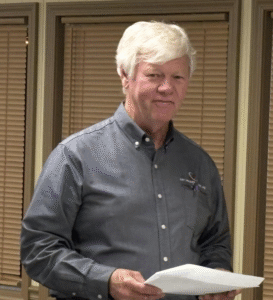
“Overall, you had a good year financially,” Loy said. With a $1.8 million increase in cash and investment balances “you are on solid footing and keeping up with inflation.”
INSURANCE POLICY
After several minutes of discussion, the board opted to switch from Wright Specialty to the Illinois Counties Risk Management Trust to provide property and liability insurance coverage at a cost of $235,061—about 26 percent less than what the district paid in premiums last year to Wright Specialty.
Richard Sedlak, an insurance broker with Schmale Insurance Agency, Belleville presented two options for the board to consider and discussed some of the advantages of one over the other. Wright Specialty proposed a policy similar to what the district currently has, except that the deductible for wind and hail damage was increased from one percent to two percent.
“A two percent deductible for wind and hail on three buildings could be a lot of money,” Owsley advised the board.
Wright’s proposed premium was $318,852—an increase of about 12 percent over what the district paid to Wright last year.
Wright also fell short on mine subsidence coverage, setting a claim limit of $750,000, compared with ICRMT’s limit of $10 million. The Trust also offered replacement costs on roofs up to 20 years in age. Wright’s coverage for earthquake damage topped out at $15 million, compared with ICRMT’s $10 million limit.
“If your concern is with earthquakes, Wright has the better program,” Seldom said. “If you’re more concerned about mine subsidence, the Trust has a better program.”
Sedlak said ICRMT is a stable company that has been in business more than 30 years. “It’s a non-accessible trust,” he said, meaning that if the company experiences a large loss, it cannot come back and reassess policy holders.
Going with ICRMT, Sedlak said, would give the district up to $30 million in coverage on the high school/middle school.
“This will be the first time you’ll have coverage that equals the value of that building,” he said. By going with the Trust, he said, “You’ll be giving up a little earthquake coverage for a lot more subsidence coverage.”
Later in the meeting, the board voted unanimously to approve ICRMT’s proposal for the coming year. The proposal includes Workers Compensation coverage through Zenith Insurance Co., the district’s current Workers Compensation carrier.
BUS PURCHASE
On a motion by Peyton Bernot, seconded by Amanda Ross, the board unanimously accepted Supt. Owsley’s recommendation to spend upward of $153,000 for a new bus from Central States Bus Sales to replace an older bus from the district’s fleet of buses. Owsley said he will pay for the vehicle from the Transportation Fund which was projected to end the year with a surplus of about $564,000. Financing the purchase, he said, would unnecessarily cost the district about six percent in interest.
“My goal is to make sure that none of our buses are more than five years old,” he said, “because that’s when depreciation ends.”
The fleet currently consists of 13 buses, seven of which are older than five years.
“We don’t need 13 buses,” Owsley said, reporting that Transportation Director Tim Besserman said he’d be comfortable with 10 buses. The district currently runs seven full bus routes.
Owsley said two buses already have been surplused, and he expects to surplus two more inoperable buses soon. The surplused vehicles are being scrapped, he said, “because scrap prices right now are more than what we can get for trade-in.”
ADMINISTRATIVE COSTS WAIVER
Following a mandated public hearing, the board approved a resolution directing the Superintendent to apply to the State Board of Education for a waiver freeing the district from keeping increases in administrative costs at five percent or less. ISBE requires a waiver whenever administrative cost increases exceed five percent. Owsley said those costs for this fiscal year are likely to increase by eight percent.
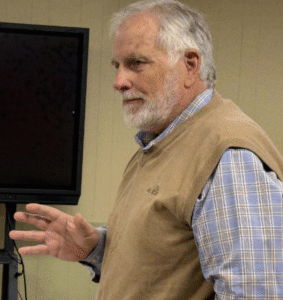
The resolution applies solely to administrative costs that fall under the Superintendent’s office. Owsley said the increased costs are attributable to mandated increases in staff salaries and increasing costs for supplies.
As part of the process, the district was required to notify the Macoupin County Federation of Teachers Local 528, along with state legislators representing the district.
PERSONNEL
The board accepted the resignation of Jennifer Brown as the high school Student Council sponsor, effective at the end of the current school year, after several years of serving in that position.
“She’s been the Student Council sponsor for a lot of years,” Bernot noted. “She was the sponsor when I was in school.”
The measure to accept her resignation also directs the district to post the position as vacant.
Board members also voted unanimously to accept the resignation of Jake Kellebrew as the district’s Bass Fishing coach and to post the position as vacant.
The resignation of Jeremy Smith as high school head baseball coach was also accepted after 16 successful seasons with the team.
DISTRICT FOCUS
During a District Focus segment, Elementary Principal Angela Sandretto introduced new teachers Nick Davio, who teaches music and fifth-grade band, and speech instructor Karen Robertson.
“Students are very excited to be in his classes,” Sandretto said of Davio. “We’re very happy to have him.”
She said the district is “very lucky” have Robertson, whom she described as a “great addition to the elementary staff.”
High School Principal Jill Rosentreter noted newly hired paraprofessionals, Shari Scott and Foli Seferi, along with newly hired custodian Tom Turiglatto. Rosentreter described the paraprofessionals as “self starters.”
GRANTS
Owsley reported the district recently received a $20,000 grant from the Illinois Arts Council to buy equipment for the high school art classroom. He also reported a $15,000 donation from Dr. Ross Billiter, and the receipt of a $50,000 matching grant for facility improvements.
Owsley singled out the administrative staff for praise following the conclusion of Principals Appreciation Week.
“I’d take my team over any other team in the state,” he said. “I can’t thank them enough. They’re here everyday and they care about every student in the district.”
“We have not had a Superintendent who has brought the amount of grant money into our district as you have,” Board President Mark Hayes told Owsley.
OTHER ACTION
In other action, the board approved moving the regular monthly board meeting for December from Monday, Dec. 22, to Monday, Dec. 15, to preclude conflicting with the holidays and winter break.




